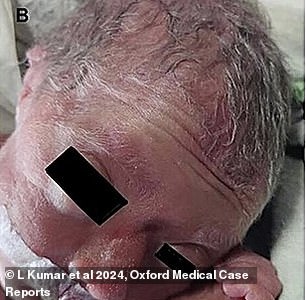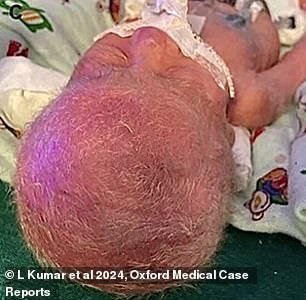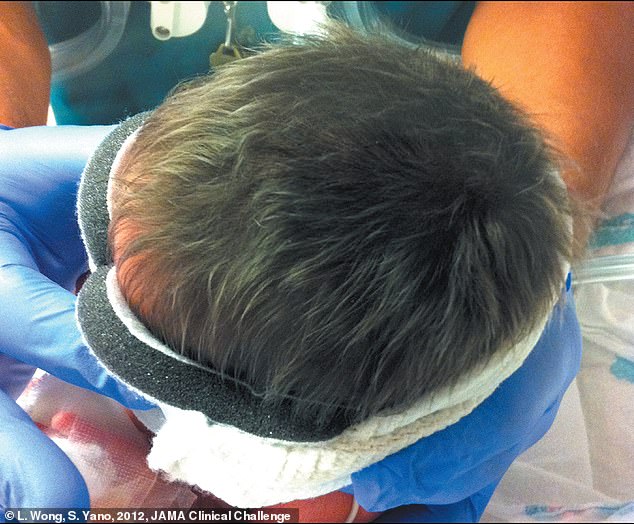Doctors have shared a surprising early sign of a one-in-a-million syndrome that’s often fatal in babies: gray hair.
Only a few hundred babies have ever been diagnosed with Griscelli syndrome, a disease that impacts their immune systems in such a way that the common cold can be fatal.
The syndrome also causes problems with the cells that give skin and hair their color. This means that babies with Griscellis have gray-white hair and sometimes a lighter skin color.
Doctors in India have highlighted two new cases in India, hoping that this will raise awareness about the syndrome and help doctors diagnose it.



Baby girl number two in the case study had gray hair on her head, and the soft, small hair all over her body was also light in color, the doctors reported
Your browser does not support iframes.
The doctors explain how to test for and treat the condition. A quick and early intervention can make a difference and save the lives of these children.
“Silver hair syndrome in the newborn may be a unique manifestation of an underlying serious systemic disease. The precise presentation of these syndromes in the neonatal period is less understood,” according to the case report by physicians at King Edward Memorial Hospital.
The two babies were born with gray-white hair at different times in India.
Both were diagnosed with Griscelli and died within months of birth, according to the case report published in the journal. Oxford Medical Case Reports.
The first child was born prematurely and her silver hair confirmed that she had Griscelli.
The child also had an older sibling who was born with silver hair and had developmental delays, but was otherwise healthy.
Doctors monitored her in the neonatal intensive care unit until she was strong enough to go home.
Just one week after being discharged from the hospital, this child returned to the hospital because her lungs were failing.
She had a septic infection and died within 24 hours, probably as a result of her syndrome.
The second child was born with soft, thin silver hair all over her body, after only 28 weeks of pregnancy.
She had a deformed left lung, but otherwise appeared stable. She was put on a ventilator to stabilize her premature body.
Doctors diagnosed her with Griscelli syndrome. In the hospital, she developed pneumonia and died.
These two cases are among only 769 people diagnosed with the condition since French physician Claude Griscelli first described it in 1978.
It is not clear how many of these cases resulted in death, but one form of the disease has been particularly deadly.
Doctors are not sure if there are more cases than recorded, but this number means that this condition affects an average of 15 people per year worldwide.
There are three types of Griscelli syndrome. Although they all share the characteristic hair growth, there are major differences in the quality of life that people with this condition can achieve with each type.
This is a genetic condition that affects the amount of pigment in the hair. Each type affects a different biological system and therefore causes different symptoms.
People with Type 1 often develop severe neurological, muscular, and developmental delays. They can often survive beyond childhood, but cannot live without help and face severe intellectual disabilities.
People with Type 2 have a history of serious infections and a weak immune system, like the two babies born in the Mumbai case study. It is the most deadly form.
This is why Griscelli syndrome is sometimes also known as partial albinism with immunodeficiencybecause the immune system is sometimes turned off.


In the USC case study, doctors were able to perform a life-saving transplant that spared the life of the child born with Griscelli syndrome
If the disease is treated early with a bone marrow or stem cell transplant, babies can survive this form. However, in many cases the disease ends in a much more serious scenario.
In severe cases of type 2, the white blood cells in the body begin to attack other blood cells. This condition is known as hemophagocytic syndrome (HS).
These abnormal cells build up in the spleen and liver, causing swelling, fever, infection, and sometimes death. Dr Saud A Alobaidaa dermatologist at King Faisai Hospital in Saudi Arabia, said: ‘HS usually leads to death unless the child receives a bone marrow transplant.’
People with type 3 lead normal lives, except for their noticeable silver eyelashes, eyebrows and hair.
Unlike the two cases in Mumbai, doctors have reported successful cases of saving babies with Griscelli syndrome.
For example, a Study from 2012 from the USC Keck School of Medicine described a successful case.
The baby was diagnosed with the syndrome shortly after birth. Because he was born with light skin and thick, gray hair, while his parents had dark skin and dark hair, doctors immediately thought something might be wrong.
‘They quickly get to work treating him and transfer him to a specialist hospital within two weeks of his birth.
At 5 months old, the child received a bone marrow and stem cell transplant. Doctors reported that the patient was alive and well three months later.



